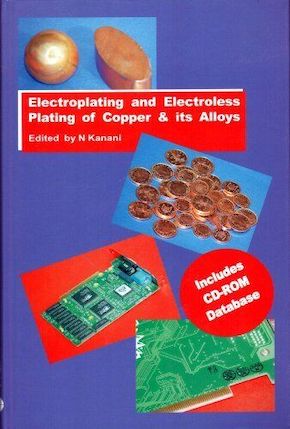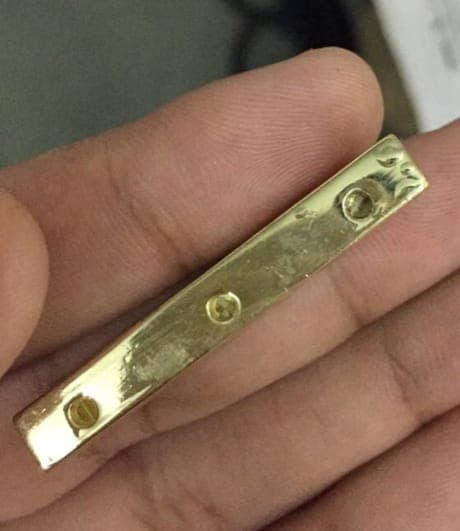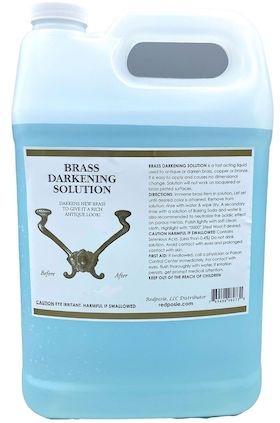
Curated with aloha by
Ted Mooney, P.E. RET

The authoritative public forum
for Metal Finishing 1989-2025

-----
Plating zinc diecast (Zamak-3): Process sequence?
⇦ Tip: Readers want to learn from Your Situation 🙂
many readers skip abstract questions.
Technical Manager - Lexington, Kentuckt
April 3, 2025
A. Hi Eric.
Zincate is an "immersion plating" process so as a general rule I would think its adhesion may not be equal to electroplating processes. A simplified explanation would be that as you're depositing the zincate you are simultaneously dissolving the substrate around and under it which it is attempting to adhere to.
What process are you doing after the zincating which is not offering good adhesion please? If you are doing brass or nickel, cyanide copper plating is normally suggested. If you are doing zinc plating, an alkaline zinc plating process is pretty nearly the same thing as a zincating solution, as Robert Probert advised us on a related thread.
Luck & Regards,

Ted Mooney, P.E. RET
Striving to live Aloha
finishing.com - Pine Beach, New Jersey
⇩ Related postings, oldest first ⇩
Q. Can anyone suggest the detailed pre-plating process sequence of Zamak-3 (alloy of zinc,Al, Mg,& Cu)?
Alloy composition is 95.5% Zn, 3% Al, 1.5% Cu, 0.2% Mg.
I am following the below mentioned process sequence.
1. Ultrasonic cleaner (Cleanum -30%) pH=7
2. soak cleaner cum cathodic cleaner at 6 V 30-60 seconds
3. water rinse.
4. water rinse
5. 0.2% sulfuric acid
6. water rinse
7. cyanide copper strike one minute
8. cyanide copper plate 10 minutes
9. dragout rinse
10. 5% sulfuric acid dip
11. Acid copper 20 minutes
12. white bronze
13. lacquer
14. baking in the oven at 140 °C
After baking for around 30-40 minutes we found blisters.
Please suggest a suitable process.
I have tried with various cleaners like HF, Ammonium bi fluoride, Phosphoric acid, citric acid and chemicals of Artek Surfin , G&W and Chemtall-Rai -- still my problem is not solved.
Am I the only person having this blister problem on zinc base upon baking in oven, or does everyone have the same problem upon baking/stoving in oven at 140 °C.
Please suggest.

Panjala Mukesh
fashion jewelry mfgr.
Hyderabad, India
2007
A. Panjala,
One of the problems with zamac 3 is air pockets and flashing occurrences in the base material that cause havoc in the plating process. Are you tumbling parts in clean media, or bead blasting? These are critical steps that must be followed. I prefer tumbling in clean media for smaller parts, it has worked well for platers I've associated with. You also want to make sure you are putting down between 25-30 microinches copper on your strike process. Try using a mild phosphoric acid dip instead of sulfuric, this may help you as well.
Mark Baker
Process Engineer - Syracuse, New York
A. Dear Mr. Panjala Mukesh
Well, however you follow the plating process, remember one thing: that after plating your articles dry them in centrifugal dryer and then bake them at 200-230 °C for minimum 5 hrs. Remember not less than 5 hrs. (more will be good). To have a good finish just clean them properly or pickle them properly.
As you are saying that you are baking at 140 °? It's not sufficient. Also don't leave your articles outside after plating for more then 20-30 mins.
Hope this could help you.
Sean Aarchr, Engineer Q.A
- Chandigarh, India
by N. Kanani

on AbeBooks or
eBay or
Amazon
(affil links)
Q. Thanks for the reply I am tumbling these zinc casted pieces, after tumbling I am flushing with fresh DI water. Coming back to Plating timings as you said 25- 30 micro inches will only come to less than one micron copper which is not sufficient to zinc castings, however I am plating around 10 microns of cyanide copper. Phosphoric acid is not helping me to get rid of blisters upon baking but to some extent 0.5% sulfuric acid is solving the purpose, but still 5- 10% of the material is getting rejected due to blisters, I want to make 0% rejections. Personnel who is dealing with zinc casted pieces please suggest the detailed pre-plating cycle.
In the second reply Mr Sean Aarchr asking me to bake in oven after plating at 200-250 °C for 5 hrs, the thing is these pieces are getting rejected at 140 °C itself, then there is no point in baking at elevated temperatures.
With MZ-82 to some extent my blister problem solved but not cent percent, so Personnel who are in the same field please guide.
Thanks
Mukesh

Panjala Mukesh
fashion jewelry mfgr.
Hyderabad, India
2007
A. If I am not wrong, you would get the problem solved if you replace the sulfuric acid in your process #5 with a cyanide base etchant (I can't recall its name).
John Hu
- Singapore
A. As I said in my reply, 25-30 microinches minimum in the copper strike. I read your process and figured the higher plating thickness is achieved in the CuCn plate. I hope you get a reply from someone knowledgeable in the field.
Mark Baker
Process Engineer - Syracuse, New York
A. Hi Panjala
In my experience it is essential to finish your electro cleaning cycle on anodic cycle.
I would doubt that a good soak cleaner would be a suitable electrocleaner as well.
If you must use a combination cleaner then make it the electro cleaner as cathodic-anodic but preferably again separate cleaners formulated for zinc diecast. Suppliers like MacDermid and Enthone will be able to advise.
You can easily overclean diecast on an anodic cycle and if so, the blisters will show grey zinc under the copper when it is prised off. Just cut back the current and/or time and acid dip just until the first gassing to remove the anodic zinc film. With cathodic cleaning your blister will show no zinc under the copper film.

Geoffrey Whitelaw
- Port Melbourne, Australia
A. Dear Mukesh,
Zamac 3 has only max amount of 0.25% copper but you have mentioned 1.5% Copper in your base metal,(zamak # 5 has approx. 1% copper).May be this is the problem, try etching your parts before plating this might help to reduce the blisters.
Sridhar Bushigampala
- Toronto, Canada
Q. Hi,
Thanks for the replies. I think Naming of Zamak 3, 5, or 27, etc., is done based on Aluminium percentage, 3 refers 3% Al.
I have reduced the blisters problem by baking the castings at 200 °C for one hour and using Surfolin MZ-82 as a soak cleaner, soaking in for 3-5 minutes, water rinse and 0.5% sulfuric acid dip , and cyanide Cu strike and cyanide copper plate for 10 minutes and acid copper and suitable finish and bake at 140 °C after E-Coat. With this sequence I have minimized the rejection rate to 5-10% but still I am not happy I am looking for better results. Earlier I have tried Cathodic cleaner followed by Anodic cleaner and 0.2% sulfuric acid , did not succeed resulted in huge amount of rejections of blisters.
Experts of Zinc die-casting, please suggest.
Mukesh

Panjala Mukesh
fashion jewelry mfgr.
Hyderabad, India
January 8, 2008
A. Hi there,
Hey I see you are using very perfect sequence for plating on Zinc , you can use GW instead MZ80 as I would never suggest you to go for cathodic cleaning which will lead into more blisters, instead I will ask you to do the cyanide copper at a very low voltage and look to it there isn't much gassing and increase the time for copper deposit, secondly using tartaric acid
⇦ this on
eBay
or
Amazon [affil links] make the neutralization dips.
Regards

Praveen Kumar
plating process supplier
Mumbai, India
February 20, 2008
A. Dear Mukesh,
A guideline for you. The problem is with the alloy of Bronze which will be creating problems. It's not advisable to cure Bronze above 120 °C.
Regards,
K Praveen Kumar Nadupuru
- Pune, Mh, India
March 6, 2009
A. Dear Mukesh
If possible avoid E-coat and use air drying lacquer which will not require any temp. for curing.
As Zn has very low melting temp. 420 °C so while baking at 140 °C there is a major changes between base metal Zn and different plating layers which weakens the intramolecular bonds.To some extent it can be controlled by increasing the cyanide & acid copper plating thickness and well controlled etching & cleaning process which you are already doing in better way.
So, finally you either change the lacquering process to air dry or increase cyanide copper plating thickness to 15-20 micron.
Hope you will get the result
Thanks

Manoj Kushwaha
plating & painting - Rampur, India
November 29, 2011
Q. Dear Sirs ,
We are a hardware injection factory for zinc alloy .
Our problem lies in the fact that we face after coating a door handle by copper cyanide, acid copper, silver, electro lacquering and being put inside oven of 120 degree - some problems such like the presence of some bubbles only on the face of the door plate that was being polished taking into your consideration that no such problems are found on the other side of the plate for door handle .
Kindly advise the best way to rinse ( wash ) the piece before coating by cyanide copper and what are the best specifications for a cyanide basis for coating.
Awaiting with high urgency with thanks in advance .
Yours faithfully
IBRAHIM SAYEGH
OWNER OF A COATING FACTORY - ALEPPO, SYRIA
February 1, 2008
A. If the blistering happens on the polished face only, two possibilities come to mind: the 'skin' is being polished too aggressively, exposing the underlying porosity, or the cleaning system is not removing the buffing compound. A good cleaning system would probably include ultrasonic cleaning followed by a proprietary alkaline electrocleaner. Please see the Metal Finishing Guidebook or the Electroplating Engineering Handbook ⇦ this on
eBay,
AbeBooks, or
Amazon [affil links]
for formulations for cyanide copper plating.

Ted Mooney, P.E.
Striving to live Aloha
finishing.com - Pine Beach, New Jersey
A. Hello all, I am working on zinc base alloy die casting and electroplating last 15 years.
1- plating on zinc base alloy casting components is very critical We do lots of trials but we succeed.
Secondly, plating field is not easy and cheap process of mind.
Plating process is electrochemistry that needs practical experience and some knowledge like base metal / casting / buffing polishing / before plating and after plating process.
2- zinc is a very sensitive metal to alkali and acid and atmosphere.
3- my suggestion is first select right material metal alloy / casting process/ buffing polishing /cleaning of after buffing polishing / cleaning before plating /cleaning after each plating / rinse water / bath temp. / all steps
4- first you select good alloy (not commercial scrap melted ) good casting process without porosity / clean in solvent use remove all polishing compound and trace /after cleaning clean with cotton cloth remove solvent trace or dip isopropyl /
5- plating process steps: hot metal cleaner suitable zinc alloy /ultrasonic cleaner / soft water dip 2/ mild acid dip /water dip 2 /dm water dip / CN copper plating high speed bath. OFHC anode use /drag dip /water dip 2 /dm dip / acid dip /water dip 2 / dm water dip / acid copper plating phosphorous copper anode use good quality / drag /water dip 3 / dm water dip / after bright copper plating, bright Ni or silver or white bronze /yellow bronze /Cr. are suitable
But all steps are done very carefully.
Kanjibhai
- Rajkot, Gujarat, India
June 29, 2011
Q. Hello to all people on finishing.com
I am a new chemist, and I work on a plating shop for a short time now. We make jewellery with barrel plating and our basic metal is zamak ks. The jewellery we make, most of them are small with small area, lets say about 1000mm squared for example.
We are trying to make nickel free gold plating with white bronze instead of nickel. Our line of plating is cathodic degreasing, acid activation, cyanide copper, acid copper and white bronze. We use acid copper because we need a gloss layer for white bronze in order to give more brilliance and gloss on gold layer.
We are facing two problems. Firstly, the acid copper does not give us a satisfactory gloss result. We operate the bath at 0.4-0.5 A/dm2 current density with a cathode area of about 400 dm2. We use phosphorized copper anodes in titanium baskets with bags from polypropylene. The temperature is room temp., the time is 30 minutes, the bath has a filter, and the brightener is periodically added with ampere hours measurement. The analysis says everything is ok. The first question then is what I am doing wrong here? Maybe it is the current density? The anode is not passivated for sure.
The second problem is white bronze. Again there is no gloss and brilliance, instead I see the articles turbid and blurred. Even the colour is not right. Again everything is ok from analysis, brighteners, etc. The bath has a filter, the temp is 60 °C , the time is 1 hour, the current density is 0.4-0.5 A/dm2 for the same cathode area 400dm2. The anodes are graphite. What can possibly be going wrong here? Is it because we can't take a result on acid copper and then white bronze copies the under-layer?
I must say that the degreasing and activation work perfect, and we have 3 rinses after each bath; and before acid copper we use a bath with very small concentration of acid (acid dip ).
This values I wrote are on data sheets from the supplier. But they have a range. Maybe the truth is somewhere there?
Thank you all very much for your time reading, and my apologies for the length of this post.
Panos Pavlidis
- Athens , Greece
June 16, 2014
Brass Plating Zinc Die Castings
Q. We have designed a product which we are having die cast in either Zamak3 or Al356 (the zinc is preferred, so that's what we'll discuss now). We had prototypes made in Al6061, which were processed with a zincate stage before going to a copper flash, and finally a double brass plating (2 dips). The samples look great! Trying to get our manufacturer to do the same is another story. The mfgr claims they cannot plate the brass without a layer of nickel over the copper, which would give us a bright-brass look, which is not our target finish.
I'm a designer/engineer, not a chemist or physicist. Can someone please help me understand enough "high-level" on this subject to help guide our mfgr on how to achieve our target double-brass finish? To my potentially misguided understanding: for zinc casting, it is just copper flash, then brass, and in our case brass a second time.(I understand there are many intermediary steps to the plating process; etches, bathes, rinses, etc., but I'm not looking for that level of detail at the moment. Not that I'm not interested, just very short on time and the amount of detailed information my head can contain.)
Additionally, we are wanting a natural look to the brass. All the plating samples we got were clear-coated to protect the brass from oxidation. We stripped all of the clear-coat off to let the parts oxidize and look natural, and they look great! I know this is not the average request from client for plating, as most people want a bright and beautiful polished look forever. not for this product. Is there a good aging solution for brass plating, that could be used prior to the clear-coat?
Any thoughts on the matter are very welcome!
Thank you!
Steven Dodson
- Gresham, Oregon
May 18, 2018
A. Hi Steven. I believe that you are right that you can copper flash then brass plate, and that by skipping the nickel plating you will get a more matte look. Your supplier claiming that he cannot skip the nickel plating may have more to do with an automatic cycle his line is set up to execute than with the needs of your parts :-) There are any number of blackening/ageing solutions for brass as long as the brass plating is heavy enough.
Regards,

Ted Mooney, P.E. RET
Striving to live Aloha
finishing.com - Pine Beach, New Jersey
Q. Hi all. I'm facing bubbles problem in electroplating. My process of plating material is first pre cleaning in ultrasonic machine, then cyanide copper, then acid copper, then nickel, then whatever the final finish is for example gunmetal or gold, etc.
I get blister problem when I bake my material after electroplating and after lacquer. I use Atotech chemicals in acid copper and nickel tank. Please experts help me if you can to solve this problem from its root.
Arshan Shaikh
- Mumbai, Maharashtra, India
May 25, 2018
Q. Hi all,
I'm facing lots of plating problems. I electroplate zinc based die casting product (mazak 3). I get bubbles problem when, after electroplating, I bake my product after lacquering process. Please help me to solve my problem

- Mumbai, Maharashtra, India
May 30, 2018
A. Hi Arshan. We added your inquiry to this thread because it seems closely related to the problem you are describing. Please review it and see if it helps at all.
Do I understand that nickel is the final electroplating step and the color comes from tinted lacquers rather than gold plating? Does the plating bubble if you bake the parts without lacquering them? When you break the bubbles, what do you see (copper or nickel on the base? nickel or lacquer on the underside of the bubble? Thanks.
Regards,

Ted Mooney, P.E. RET
Striving to live Aloha
finishing.com - Pine Beach, New Jersey
Q. Thank you so much for your reply, Ted Mooney. No, nickel is not the final step. Nickel I use for local market. Sometimes export-oriented product requires nickel-free plating so I give high shine in acid copper then whatever final finish -- for example, gunmetal or gold or nickel-free white finish, etc.
The problem I face is: when I pre-clean and then cyanide copper, then I directly do nickel, and after that gold plating, then lacquer; then I bake at 120 °C so no bubbles comes on my product.
But when export oriented product requires nickel-free plating I pre-clean it, then cyanide copper, then acid copper, then whatever final finish like gold or gun metal, then drying in the dryer; then I lacquer it and bake: bubbles come on 70-80%.
What I want is I want my product to get baked at 120 °C for 20 mins so I will get high shine and lacquer hardness. How do I achieve it.
The photo which I had shared here is nickel-free golden plating. After baking I got those bubbles.
Arshan Shaikh [returning]
- Mumbai, Maharashtra, India
May 31, 2018
A. Sir if you're facing bubbling problem according to me use triple stage ultrasonic cleaner for cleaning. Your polishing materials are not cleaned properly and that's why bubbling is seen
Robin puri
- Ludhiana.Punjab India
July 17, 2018
A. Hi Arshan.
I too faced the same bubbling problem. It is more due to high temperature. I reduced the baking temperature to 100 °C and increased the curing time to 1 hour.
By this the bubbling has been solved.
Sunil Dhanuka
- Kolkata. India
November 19, 2018
Zamac corrosion resistance
Q. Dear All,
I want to ask some questions about zamac plating process.
a) Twice copper plating is a must?
b) What is the main reason of second copper plating?
c) Can we make only first (alkaline) copper plating if surface is enough good (no need polishing)
d) For 200 hour NSS expectation, is semi bright nickel plating before bright nickel a must?
e) Can we reach 200 hours only bright nickel with thick plating?
Thanks for information.
Gence Tas
- Turkey
November 26, 2018
A. Hi cousin Gence. Please start by telling us who you are, what you do, and about the parts and application. Have you been successfully producing parts for many years now and been passing the NSS test by using two layers of copper and two layers of nickel and now you are interested in cost reduction? Or have you never yet plated any parts but you want to cut some corners? :-)
I'm not trying to harass you, just to advise that starting with abstract questions is not usually the way decisions are made or plating installations are designed. Plating cost usually work this way: if you have almost no rejects you'll do fine financially, but if you have substantial rejects you'll go broke no matter how cheap your plating cycle :-) So the usual approach is to make sure you don't build a touchy plating cycle which will work only when everything is perfect; rather, you try your best to design a robust plating cycle where small variations somewhere will not mean that bad parts are produced.
The quality and porosity of diecastings is a perennial problem, too, so each separate layer of plating reduces the chance of pinholes penetrating through. When you look at it that way, yes, double copper plating and duplex nickel is a good idea, although not mandatory.
NSS is not usually specified for testing nickel-chrome plating because it's not really a "consumable" plating where the number of hours can actually measure anything -- usually either you'll fail quickly due to pinholes & porosity or it will resist NSS nearly forever, so 200 hours should be okay. Usually, CASS (ASTM B368) or Corrodkote (ASTM B380) is specified instead. Nickel without chrome will quickly tarnish badly.
Regards,

Ted Mooney, P.E. RET
Striving to live Aloha
finishing.com - Pine Beach, New Jersey
by Safranek & Brooman
on AbeBooks
or Amazon
(affil links)
Q. Hello ,
We are a zamak casted hardware manufacturing company; we mainly produce hardware for leather articles such as buckles, loops , sliders, etc. For past one year we have been running our own electroplating plant.
I had no prior experience of electroplating and have learnt a lot in past year. Now the main issue is that I am not able to solve the problem of blistering on finished product. Following is my procedure:
Ultrasonic cleaning
Drag out
Acip dip (1% sulfuric)
Dm rinse
Cathodic cleaning
Drag out
Acip dip (1% sulfuric)
Dm rinse
Dip in dm water with free sodium cyanide
Plating in Rochelle based cyanide copper for 10 mins
Now from here we do acid copper, followed by several post finishes depending on buyers requirement and then lacquering (we use either e-coat or dip lacquer) baking at different temperatures based on type of lacquer.
Now what my experience says is that either we are not able to give required thickness in cyanide copper or we are doing something wrong in our cleaning process.
The ratio of metal and cyanide maintained is Cu metal 25-30 gm/ltr and NaCN - 8-9 gm/ltr (bath volume 1000 ltrs) working temp 42 °C.
Also the copper metal content in this bath never reduces, instead it keeps on increasing which forces us to dilute in Order to maintain the composition.
We only add free cyanide or sodium potassium titrate to this bath.
We have had several representatives from various chemical manufacturing companies visit my plant but no one has offered any good solution
Someone suggested to add a strike copper tank before doing Rochelle copper; they suggest to maintain copper metal at 4 gm/ltr and NaCN at 1-2 gm/ltr in that tank and use high voltage for 1 min at room temp.
Please help.
Arpit Jain
- New Delhi, India
June 2, 2019
A. Arpit.
Your process looks entirely conventional, and should produce blister free plating.
You should determine whether the acid copper plating is separating from the copper strike, or both layers are blistering from the zinc.
10 Minutes in the copper strike may not provide enough thickness to be pore free. The acid copper bath would then attack the zinc, resulting in blisters Try increasing either time or current by 50%.
If a careful observation shows separation between the two copper layers, then you will need to improve your post-strike rinsing, and possibly introduce a weak sulfuric dip and rinse prior to final copper plating.

Jeffrey Holmes, CEF
Spartanburg, South Carolina
A. Dear Arpit,
In addition to the above I would also scrap the cathodic cleaning cycle which could be initiating the blister formation. If your ultrasonic cleaning is good enough and clean enough there is no need for Cathodic.
4
Khozem Vahaanwala
Saify Ind
![]()
Bengaluru, India

Q. Hello,
I am Sudharshan Velusamy from India.
Is it possible to plate Zinc or Zinc/Nickel on Zamak for barrel application? What would be the ideal process sequence, if yes to achieve minimum 240 Hours to WR.
Sudharshan Velusamy
- Bangalore, India
September 29, 2022
A. Hi Sudharshan. Yes, you can follow the prep cycles on this page, then plate the Zamac with cyanide copper first or directly with alkaline or cyanide zinc. With a heavy enough plating for consistent chromating you should be able to achieve 240 hours to white rust. But 'ideal process sequence' for truly robust barrel plating of diecastings is a tall order :-)
Luck & Regards,

Ted Mooney, P.E. RET
Striving to live Aloha
finishing.com - Pine Beach, New Jersey
A. Regarding Plating of ZAMAK, whatever your plating procedure, I have always experienced blistering when preparing by etching the base metal with sulfuric acid.
The Z in ZAMAK is Zinc. Remember chemistry class? Zinc nodules in the sulfuric acid is rather vigorous. Zinc agglomerates into large-ish crystals at the surface. H2SO4 eats at these vigorously, sometimes getting into pores and around the backside of these large-ish chunks of Zn.
The rinse won't get these interstitial remnants of H2SO4. So there are pockets of redox left behind to get plated over. The bubbles, from Hydrogen and Zinc Sulphide are left to expand and blister during the bake out.
Use Phosphoric acid on the base ZAMAK.
Retired Eng - Mauston Wisconsin
May 3, 2023
RFQ: I am interested to make an electroplating plant in India.
Walid Hilal
- Dubai UAE
November 18, 2022
Ed. note: This RFQ is outdated, but technical replies are welcome, and readers are encouraged to post their own RFQs. But no public commercial suggestions please ( huh? why?).
Q, A, or Comment on THIS thread -or- Start a NEW Thread

